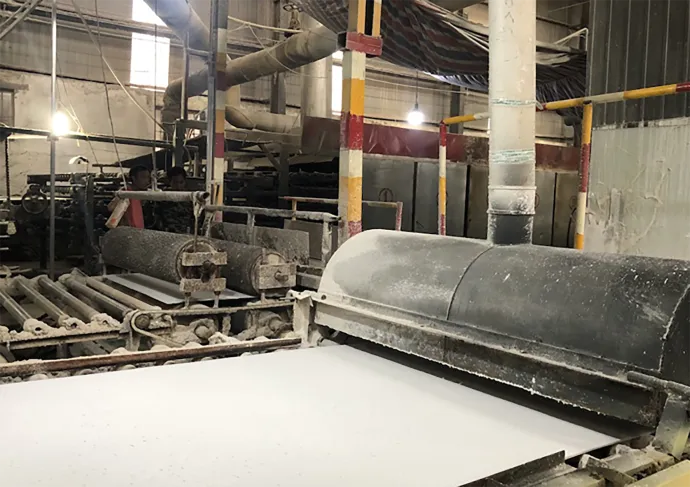Nov . 07, 2024 16:59 Back to list
Comparing Gypsum and PVC Ceilings for Your Home Renovation Needs
Gypsum vs. PVC Ceiling A Comprehensive Comparison
When it comes to choosing the right ceiling material for residential or commercial spaces, two popular options often come to the forefront gypsum and PVC (polyvinyl chloride). Both materials have their unique attributes, advantages, and disadvantages, making them suitable for different applications and settings. This article aims to delve into the characteristics of gypsum and PVC ceilings, exploring their benefits and drawbacks to help you make an informed decision.
Gypsum Ceilings
1. Material Overview Gypsum ceilings are made from gypsum boards or panels. Gypsum is a natural mineral composed of calcium sulfate dihydrate, known for its fire-resistant properties. Gypsum boards are typically installed by attaching them to a metal or wooden frame.
2. Aesthetic Appeal One of the standout features of gypsum ceilings is their aesthetic versatility. They can be painted or textured, allowing for a broad spectrum of design possibilities. Gypsum ceilings can also be shaped into intricate designs, offering a luxurious look that could elevate the overall ambiance of a space.
3. Fire Resistance Gypsum’s inherent fire-resistant qualities make it a safer option for home and commercial installations. In the event of a fire, gypsum can help slow down the spread of flames and smoke, providing valuable time for escape or fire control.
4. Sound Insulation Gypsum ceilings are excellent at absorbing sound, making them ideal for spaces where noise reduction is a priority, such as theaters, offices, and conference rooms. The density of gypsum helps in minimizing sound transmission, thereby enhancing privacy.
5. Cost and Installation While gypsum ceilings can be cost-effective for many applications, their installation often requires skilled labor and can be time-consuming, especially for complex designs.
Disadvantages of Gypsum Despite these advantages, gypsum ceilings are not without downsides. They can be heavy, requiring a robust supporting structure. Moreover, they are susceptible to moisture damage, which can lead to warping and mold if not properly treated. In areas with high humidity, maintenance can become an issue.
PVC Ceilings
gypsum vs pvc ceiling

1. Material Overview PVC ceilings are made from plastic materials, specifically designed to provide an economical alternative to traditional ceiling types. PVC is lightweight and comes in various designs and colors, making it a favored choice for modern interiors.
2. Aesthetic Appeal Much like gypsum, PVC ceilings offer a plethora of design options. They come in various patterns, textures, and colors, allowing homeowners or designers to select a style that complements the overall design scheme.
3. Waterproof and Moisture Resistant One of the most significant advantages of PVC ceilings is their waterproof nature. Unlike gypsum, PVC does not absorb moisture, making it an excellent choice for areas prone to humidity, such as bathrooms and kitchens. This characteristic also helps in preventing mold growth, ensuring a healthier indoor environment.
4. Low Maintenance PVC ceilings require minimal maintenance; they can be easily cleaned with a damp cloth, and they do not need painting or regular upkeep. This low-maintenance requirement is particularly appealing for busy households or commercial settings.
5. Cost and Installation PVC ceilings can be more affordable and simpler to install compared to gypsum ceilings. The lightweight nature of PVC makes it easier for homeowners to take on DIY projects, reducing labor costs.
Disadvantages of PVC However, PVC ceilings may not provide the same level of sound insulation as gypsum. They can also be less sustainable, as they are made from plastic, which contributes to environmental concerns. Furthermore, cheaper PVC options may be less durable and prone to fading or discoloration over time.
Conclusion
In conclusion, both gypsum and PVC ceilings have their merits and drawbacks. Gypsum ceilings offer a sophisticated aesthetic with excellent fire resistance and sound insulation, making them suitable for a variety of environments. On the other hand, PVC ceilings stand out for their waterproof capabilities, low maintenance, and affordability, making them an attractive option for areas susceptible to moisture.
Ultimately, the choice between gypsum and PVC ceilings should be informed by the specific needs of your space, including aesthetic preferences, environmental conditions, and budget constraints. By carefully considering these factors, you can make the best decision for your ceiling installation project.
-
Quality Ceiling Trap Doors & Access Panels | Easy & Secure AccessNewsAug.30,2025
-
Durable Ceiling T Grid Systems | Easy InstallationNewsAug.29,2025
-
PVC Gypsum Ceiling: Durable, Laminated Tiles for Modern SpacesNewsAug.28,2025
-
Pvc Gypsum Ceiling Is DurableNewsAug.21,2025
-
Mineral Fiber Board Is DurableNewsAug.21,2025
-
Ceiling Tile Clip Reusable DesignNewsAug.21,2025







